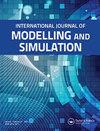Flow of magnetized Powell-Eyring fluid in microchannel exposed to non-linear radiation and constricted to slip regime by varying viscosity
IF 3.1
Q1 ENGINEERING, MULTIDISCIPLINARY
INTERNATIONAL JOURNAL OF MODELLING AND SIMULATION
Pub Date : 2023-05-30
DOI:10.1080/02286203.2023.2216049
引用次数: 0
Abstract
ABSTRACTThe present article exemplifies flow of Powell-Eyring fluid flowing in the microchannel which is placed horizontally. For this microfluidic flow, fluid is sucked and injected through the walls of the microchannel. The microchannel is also influenced by magnetic field and exposed to the non-linear radiation due to its extensive application to process the polymers, as the ultimate product quality relies on the heat controlling factors. Interest is laid on studying flow manner by differing viscosity. Flow is facilitated by slip and convective conditions. Non-linear equations are solved using finite difference code improved by using the Lobatto IIIA formula with the help of MATLAB software and findings are discussed using graphs. Results attained from the analysis claim that Powell-Eyring fluid parameters decline the velocity of the flow and enhance the skin-friction. The main concern of the present work is to maximize the heat transfer which could be attained by keeping Prandtl number low, thus for higher momentum diffusivity exhaustion in the heat transfer rate is recorded. Reynolds number also turns out to be critical factor as it accelerates the fluid flow at the suction wall and decelerates the velocity at the injection wall.KEYWORDS: Eyring-Powell fluidvelocity slipnon-linear radiationvariable viscosityconvective conditions Nomenclature a=Distance between the plates m;B0=Magnetic field strengthAm−1;Be=Bejan number;Bi=Biot number;B,C=Material fluid parameters;cp=Specific heat at constant pressure (Jkg−1K−1);ℎ=Convective heat transfer coefficientsWm−2K−1;Ec=Eckert number;k=Thermal conductivity (W/m k);M=Magnetic;p=Pressure kgm−1s−2Pr=Prandtl number;Rd=Non-linear radiation parameter;Re=Reynolds number;T=Fluid temperature (K);Ta=Ambient temperature (K);Th=Hot fluid temperature (K);θ=Dimensionless temperature;u=Dimensionless velocity;u ′=Axial velocitym/s;Greek symbols σ=Electrical conductivity(S/m);v0=Uniform suction-injection velocityms−1μ=Dynamic viscositykgm−1s−1α=Slip parameterξ=Stephan-Boltzmann constantWm−2K−4;φ=Mean absorption co-efficientm−1λ=Viscosity variation parameter;λ1λ2=Eyring Powell fluid parameters;ρ=Density(kg/m3);Subscript 1,2=Lower and upper plates respectively;Disclosure statementNo potential conflict of interest was reported by the author(s).Additional informationNotes on contributorsB. J. GireeshaDr. B. J. Gireesha is an eminent researcher who has obtained Doctoral degree from Kuvempu University in the year 2003. The author has competed post-doctoral research in Cleveland State University, Ohio and has attained prestigious Raman fellowship-2015 for post-doctoral research for Indian scholars in USA. He is a researcher of high rank and has reviewed numerous research articles for various National and International journals. He has published more than 280 research articles and possesses an ability to reason analytically and rationally with a sound judgement.S MantheshaDr. S. Manthesha, Lecturer, Department of Mathematics, Taproot Group of Colleges, Bangalore, Karnataka, India. He obtained his Ph.D degree from Tumkur University, Tumkur in the year 2022. He has 5 years of teaching and research experience and is a potential researcher in field of fluid mechanics.F. AlmeidaDr. Felicita Almeida obtained the Ph.D degree from Kuvempu University and is a potential researcher in the field of fluid mechanics especially in flow of non-Newtonian fluid in microchannel. The author has a strong hold on numerical computation and technicality of the paper.P. MallikarjunDr. Patil Mallikarjun, Professor, Department of studies and Research in Mathematics, Tumkur University, Tumkur, Karnataka, India. He obtained his Ph.D degree from Gulbarga University, Kalaburagi in the year 2007. His area of research is heat transfer and fluid flow problems, flow analysis in microchannels.磁化鲍威尔-埃环流体在非线性辐射下的微通道流动,随着粘度的变化而收缩到滑移状态
摘要本文举例说明了鲍威尔-埃环流体在水平放置的微通道中的流动。对于这种微流体流动,流体通过微通道的壁被吸入和注入。微通道广泛应用于聚合物的加工,同时也受到磁场和非线性辐射的影响,最终产品的质量取决于热控制因素。研究了不同粘度下的流动方式。滑移和对流条件有利于流动。在MATLAB软件的帮助下,利用Lobatto IIIA公式改进的有限差分代码对非线性方程进行求解,并用图形对结果进行了讨论。分析结果表明,鲍威尔-埃环流体参数降低了流动速度,增加了表面摩擦。本工作主要关注的是保持较低的普朗特数可以达到最大的换热,从而在换热速率中记录较高的动量扩散率耗尽。雷诺数也被证明是一个关键因素,因为它加速了流体在吸力壁上的流动,降低了注射壁上的速度。关键词:术语a=板间距离m;B0=磁场强度am - 1;Be=Bejan数;Bi=Biot数;B,C=材料流体参数;cp=恒压比热(Jkg−1K−1); =对流换热系数swm−2K−1;Ec=Eckert数;k=导热系数(W/m k); m =磁性;p=压力kgm−1s−2Pr=普朗特数;Rd=非线性辐射参数;Re=雷诺数;T=流体温度(K);Ta=环境温度(K);Th=热流体温度(K);θ=无量纲温度;u=无量纲速度;u ' =轴向速度m/s;希腊符号σ=电导率(s /m);v0=均匀吸注速度ms - 1μ=动态粘度kgm - 1s - 1α=滑移参数ξ=Stephan-Boltzmann常数m - 2K - 4;φ=平均吸收系数m - 1λ=粘度变化参数;λ1λ2=Eyring Powell流体参数;ρ=密度(kg/m3);下标1,2分别=上下板作者报告了利益冲突。附加信息:贡献者说明j . GireeshaDr。B. J. Gireesha是一位杰出的研究人员,于2003年获得库文普大学博士学位。作者曾在美国俄亥俄州克利夫兰州立大学竞争博士后研究,并获得著名的拉曼奖学金-2015印度学者赴美博士后研究。他是一名高级研究员,在各种国内和国际期刊上发表了许多研究论文。他发表了280多篇研究论文,并具有分析和理性推理的能力,具有良好的判断力。MantheshaDr。S. manshha,印度卡纳塔克邦班加罗尔塔普罗特学院数学系讲师。他于2022年在图姆库尔大学获得博士学位。他有5年的教学和科研经验,是流体力学领域的潜在研究者。AlmeidaDr。Felicita Almeida博士毕业于库文普大学,是一名在流体力学领域特别是在微通道中非牛顿流体流动方面有潜力的研究人员。作者对数值计算有较强的把握,论文的专业性强。MallikarjunDr。Patil Mallikarjun,印度卡纳塔克邦图姆库尔图姆库尔大学数学研究系教授。他于2007年在Kalaburagi的Gulbarga大学获得博士学位。他的研究领域是热传递和流体流动问题,微通道中的流动分析。
本文章由计算机程序翻译,如有差异,请以英文原文为准。
求助全文
约1分钟内获得全文
求助全文
来源期刊

INTERNATIONAL JOURNAL OF MODELLING AND SIMULATION
Engineering-Industrial and Manufacturing Engineering
CiteScore
6.10
自引率
32.30%
发文量
66
期刊介绍:
This journal was first published in 1981 and covers languages, hardware, software, methodology, identification, numerical methods, graphical methods, VLSI, microcomputers in simulation, and applications in all fields. It appears quarterly.
 求助内容:
求助内容: 应助结果提醒方式:
应助结果提醒方式:


